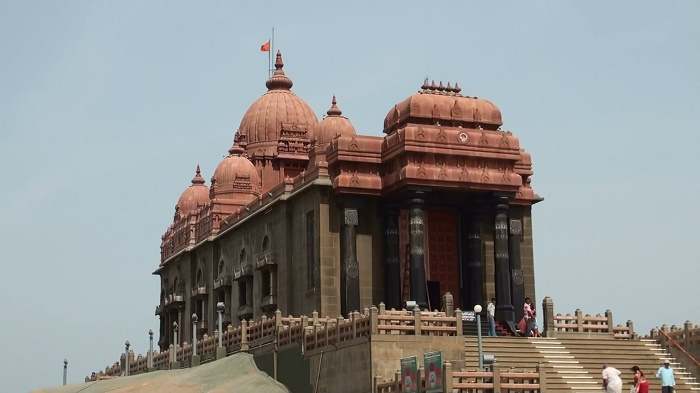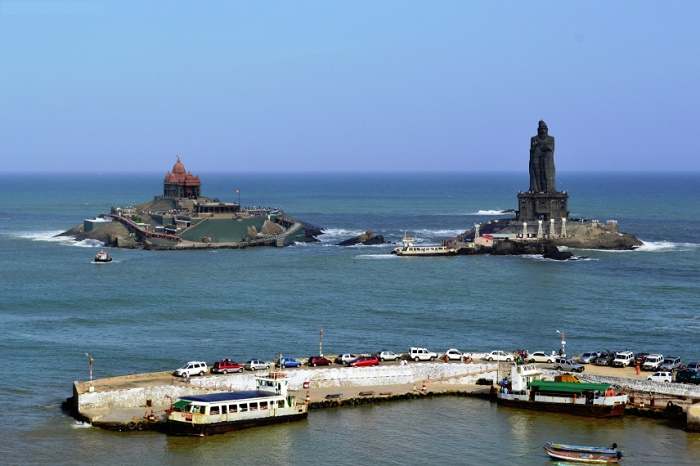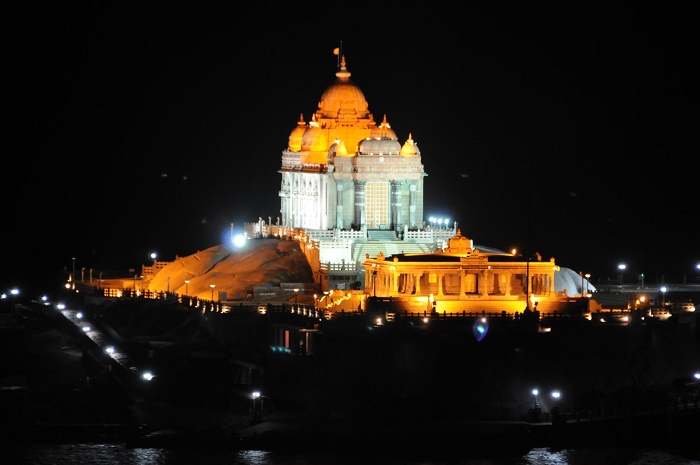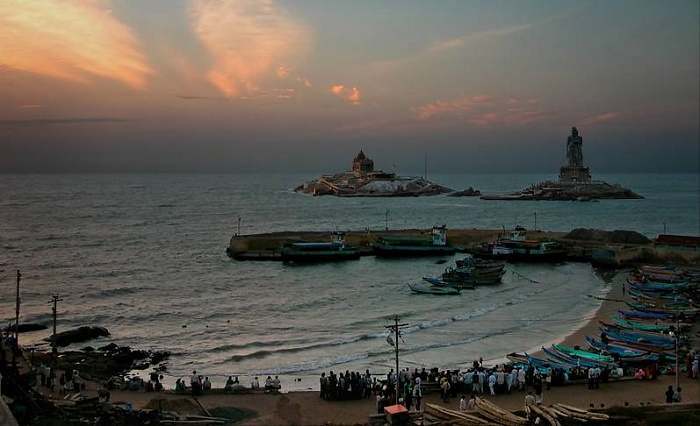When was it built: 1970
Time taken: 6 Years
Where is it located: 500 m east of mainland of Vavathurai, Kanyakumari, India
Why was it built: As a memorial to Swami Vivekananda
Architectural Style: Mix of conventional and modern architectural styles of India
Visit Timing: Daily, 7.00 am to 5.00 pm
How to Reach: Kanyakumari is connected by bus with major south Indian cities and by rail with several Indian cities while the nearest airport is at Trivandrum (67 Km). One can avail ferry service from Kanyakumari to reach Vivekananda Rock.

The colossal and imposing ‘Vivekananda Rock Memorial’ is located offshore around 500 m east of mainland of Vavathurai, Kanyakumari, in the southernmost tip of India. It is seated on one of the two adjacent rocks projecting out of the Lakshadweep Sea and comprises of two important structures, the ‘Shripada Mandapam’ and the ‘Vivekananda Mandapam’. This awe-inspiring memorial was constructed in honour of the great spiritual leader and Hindu monk of India, Swami Vivekananda who is said to have attained enlightenment here after meditating for two days prior to his famous Chicago trip. This rock is also considered sacred as local legends say Goddess Devi Kumari blessed the rock while performing austerity. The memorial today stands as an architectural chef d'oeuvre illustrating various architectures styles of India and attracts thousands of visitors round the year. A boat cruise to the place, the only way of transport, makes the trip more enjoyable to visitors.
Establishment of ‘Vivekananda Rock Memorial
Swami Vivekananda visited Kanyakumari on December 24, 1892, prior to his Chicago trip to take part in the 1893 ‘World Religious Conference’. It is said that he meditated on the rock for two days and attained enlightenment. He was one of the eminent disciples of Ramakrishna, an Indian mystic and yogi of the 19th century, and later played an instrumental role in introducing Indian philosophies of Yoga and Vedanta to the Western countries. In January 1962, marking the birth centenary of Swamiji, the ‘Kanyakumari Committee’ was set up by a group of people who aimed at establishing a memorial of Swamiji on the rock as also a bridge for people to visit the rock. The ‘Ramakrishna Mission’ in Madras also conceived of such a memorial during that time. However the concept met with certain hurdles with the local Catholic fishermen displaying aversion and putting up a big Cross on the rock and on the other hand the Hindus were protesting such move of the Catholic populace. As matters became worse, the rock was marked as a prohibited place and armed guards were stationed to patrol it. On January 17, 1963 as permitted by the government, a tablet was put up at the rock that mentioned its association with Swami Vivekananda.

Eknath Ramkrishna Ranade & the Memorial
Eknath Ramkrishna Ranade, an eminent Indian social and spiritual reformer and a senior pracharak of the ‘Rashtriya Swayamsevak Sangh’ (RSS) who was profoundly influenced by the teachings of Swamiji played an instrumental role in setting up the memorial. He set up the ‘Vivekananda Rock Memorial Organising Committee’ that soon opened up several branches in India to garner support and raise funds in pursuit of establishing the memorial. As political hurdles cropped up including rejection of the concept by Humayun Kabir, the then Minister of Education and Culture, as also from Chief Minister of Madras state, Minjur Bhaktavatsalam, Ranade went on to collect signatures of 323 Members of Parliament in support of the memorial following which the then Prime Minister of India, Smt. Indira Gandhi approved the project. The construction of the Vivekananda Rock Memorial was completed in a short span of six years in 1970, which involved around 650 workers. It was inaugurated and dedicated to the nation in that year.

The Memorial at a Glance
A mix of conventional and modern architectural styles of India, particularly a blend of Tamil Nadu and West Bengal style of architecture is palpable from the design of the memorial. While the Memorial Mandapam resembles Sri Ramakrishna Temple at Belur, West Bengal, the design of its entrance features architectural styles of Ajanta and Ellora. It houses a life size bronze statue of Swami Vivekananda standing in his famous ‘Parivarjak’ posture that was made by famed sculptor Sitaram S. Arte. Vivekananda Rock is also called ‘Sripada Parai’ as it is believed that Goddess Devi Kumari blessed the place with the touch of her holy feet. In reality the rock has a projection that is brownish in colour and looks like a human footprint. This projection is considered and referred as Sri Padam and a shrine called ‘Sri Padaparai Mandapam’ was constructed at the spot.
One of the two principal structures of the memorial is the main sanctum sanctorum, the ‘Shripada Mandapam’, which is enclosed within an outer platform. This hall, square in shape also includes a ‘Garbha Graham’, an ‘Inner Prakaram’ and an ‘Outer Prakaram’. The other main structure is the ‘Vivekananda Mandapam’ built in honour of Swamiji. The sections included in this structure are the ‘Dhyana Mandapam’, ‘Mukha Mandapam’, Namashtubhyam to the Son of jagadamba and ‘Sabha Mandapam’. Design of the ‘Dhyana Mandapam’ or meditation hall displays integration of various styles of temple architecture of India. The mandapam that allows visitors to sit, relax and meditate in a calm and peaceful atmosphere has 6 adjacent rooms. The ‘Sabha Mandapam’ is the Assembly Hall that consists of a statue section called ‘Pralima Mandapam’, a corridor and an outer courtyard encompassing the hall. The statue of Swamiji is positioned in such a way that his vision directly falls on the Shripadam.

Establishment of ‘Vivekananda Kendra'
On January 7, 1972, Ranade founded the spiritual organisation called ‘Vivekananda Kendra’ beside the memorial. The organisation based on the principles preached by Swami Vivekananda has spread its wings in more than 18 states of India that include 600 branch centres and more than 200 full-time dedicated workers. Activities of the organisation include conducting rural development activities, Yoga classes and seminars.

Image Credit: wikipedia
A Visit to the ‘Vivekananda Rock Memorial'
This sacred memorial symbolising purity and unity preached by Swami Vivekananda has over years emerged as one of the most revered memorials of India and one of the must visit destinations of Kanyakumari. The rock also offers a striking view of the confluence of the Indian Ocean, the Bay of Bengal and the Arabian Sea. It can be visited on any day throughout the year from 7.00 am to 5.00 pm. Charges for entry fee is Rs. 10/-, still camera is Rs. 10/- and video camera is Rs. 50/-.



